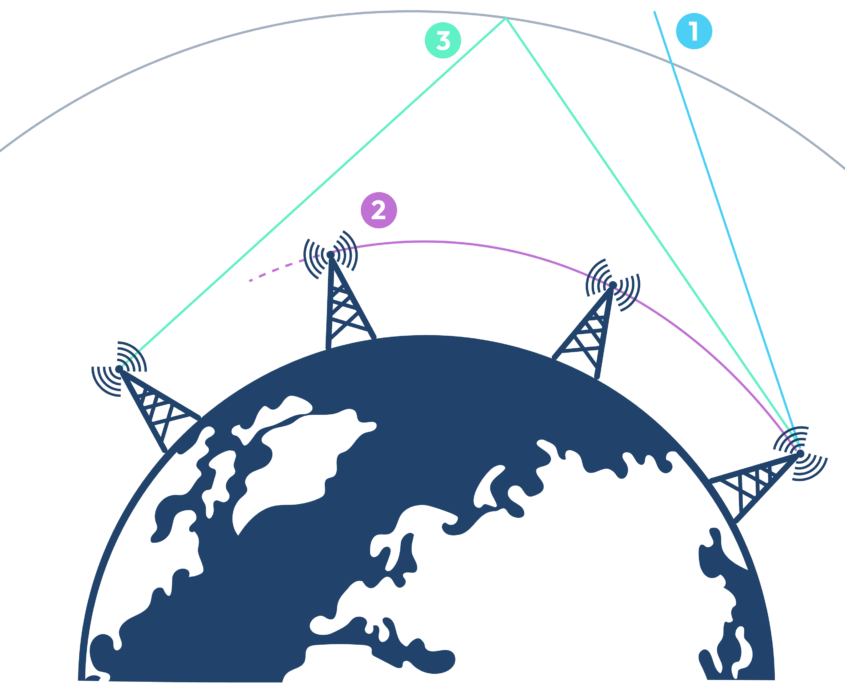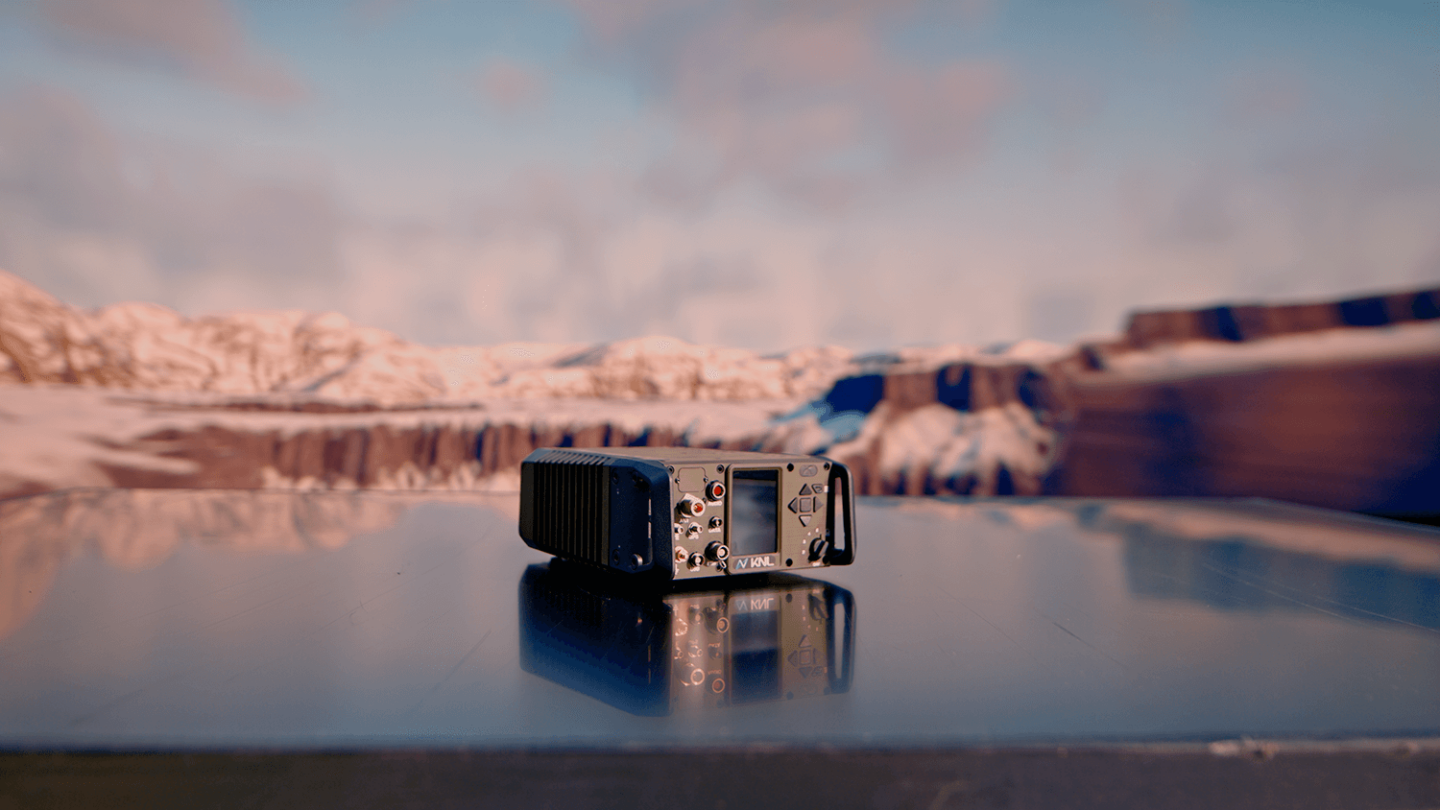Basics of HF Technology
HF technology basics and legacy use
Starting with the evolution of HF technology.
Compared to the VHF (Very High Frequency) or UHF (Ultra High Frequency) bands, the characteristics of HF technology are unique. While the propagation range of VHF and UHF is limited to line-of-the-sight, i.e. some tens of kilometers, HF is able to propagate over thousands of kilometers. Thanks to this, it’s possible to establish a signal between continent to continent.
There’s a lot to HF technology. The frequency band still benefits from Line of Sight propagation, identical to VHF and UHF propagation modes, and through Ground Wave (GW) propagation that conducts via the surface of earth (sea or land) up to 500 NM, i.e., over much longer distances than LOS.
The extreme long-range HF links are established with the help of the Ionosphere, which reflects some of the HF frequencies back to the surface of earth. This is called the sky wave (SW) propagation where, in a sense, the ionosphere acts as a natural satellite for the HF signals.
The ionosphere also comes with its own set of challenges. The constantly changing state of the ionosphere dictates the characteristics of the HF propagation range and level of signal distortion.
> By the International Telecommunication Union (ITU) definition, the frequencies between 3 MHz – 30 MHz are called the high frequencies.

>> Illustration of how different types of radio waves travel
Luckily it’s possible to estimate HF propagation through standard variables, defined by the Time of the day, Date, Year, the Space weather, and the user Coordinates (listed shorthand as TDYSC), implying that there are both predictable and unpredictable factors affecting the propagation.
Complicating matters, there are both short and long-term fluctuations on the HF channel. The short-term phenomena, like signal distortion, are always very unpredictable by the nature. Furthermore, it is necessary to understand that TDYSC based ionosphere status is valid only per “channel” (transmission frequency), within about 500 kHz. Frequencies apart more than 500 kHz could experience totally different SW propagation even though they share the same TDYSC parameters.
As a result, to establish and maintain a long-range data link over HF channel between two HF radios, each radio would have to be able to correctly choose a channel that propagates at the exact moment based on the TDYSC information.
In practice, that would be just the first step. Next, it would have to be figured out if the channel is free from the other users or interference (it’s possible to see a lot of interference on a HF channel). Then the chosen channel, together with the communication parameters, would have to be informed to the distant user (the receiver), so that the receiver is able to tune to the same channel with adequate set of communication parameters. On top of that, the preparedness to change the channel whenever required needs to be very high. This would be the case if some other user (with much higher transmission power) occupies the same channel, or the state of the ionosphere changes in favor of some other channel.
Traditionally, the well-trained HF operators have tackled HF communications by using their experience (and the ears) in managing the tricks of HF channel selection. Thanks to this, only voice or telegraphy have been the realistic communication methods.
There have been serious attempts to overcome these difficulties. During the 80’s and 90’s, second generation (2G) ALE and third generation (3G) ALE protocols (Automatic Link Establishment) were developed and eventually standardised by militaries. ALEs alleviate some of the skills required from the radio operator by adding automatic methods to initiate and maintain a common HF channel between the transmitter and the receiver.
But the main drawbacks of both generations of ALEs are frequency agility and the channel selection speed. As a consequence, both ALE methods are simply too low performing to be able to secure the stability needed for internet services over HF band.
Contact us for more information!
Legacy No More – What would we need to do to exploit the full potential of HF technology for global communication?
To rethink HF technology, first of all we need to forget all that old stuff, like 2nd Generation and 3rd Generation ALEs and more or less abandon all the legacy-contaminated standards. The hardware of most of the existing HF transceivers needs to be gotten rid of as well. For short: we need to start from scratch!
The key to master HF technology is to be adaptive, cognitive and very frequency agile, in the fastest way possible. To do so, one would need high performing radio hardware with powerful DSP (Digital Signal Processing), as well as efficient algorithms to exploit the DSP capabilities. On top of that, you would need tailored protocols to offer the robust bit pipe to the IP layer and the applications communicating over HF.
Nowadays it’s is possible to fulfil all of the above-mentioned requirements thanks to the evolution of ADC (Analog to Digital Converters) chips.
ADC is the one component that transforms the analog HF signal to digital form, i.e., from waves to bits. Due to state-of-the-art ADCs, the whole HF band is possible to digitalise straight from the HF antenna. Now with the signal in the digital domain, the variables related to signal processing, decoding, and finding the right HF radio to connect to is much easier than first using some analog signal processing stages in the radio.
This kind of radio is an ideal software radio. The widely used term software defined radio, in turn, has more hardware determined restrictions since there are some analog signal processing between the antenna and ADC. There’s a small but significant difference when considering, for example, the flexibility of the radio regarding the communication parameters listed above.
The system radio frequency (RF) bandwidth and the consequent symbol rate on HF are usually much lower than most VHF/UHF systems. The system symbol rate has a direct effect on the computational complexity of the signal processing. Thanks to a couple magnitudes lower symbol rate on a digital HF receiver, much more efficient signal processing is possible to implement than, for example, used in many cellular technologies. The effective signal processing is in paramount when decoding the user data from the distorted SW signal.
With this kind of setup we would have a HF radio capable of receiving and digitalising the whole HF band, have enough DSP power to do the many tricks needed to establish and maintain a robust link between two distant HF radios, and above all, could constitute a robust bit pipe that could bear Internet traffic over the HF channel.
So, why haven’t anyone done this before?
Beyond Legacy with KNL
Actually, it’s already been done!
KNL designed and implemented a HF radio with technology just like described above. It takes in the whole HF band, finds an operational channel extremely fast, and is ready at all times to change the channel to avoid other users and interference. Most importantly of all, it supports data rates suitable to many internet services. All this has been done with the help of cognitive principles that decide how the operational channel is chosen and maintained.
KNL’s HF radio is not just the most innovative cognitive HF radio in the world, but should be seen as a user terminal on a multiradio platform. In addition to HF interface, KNL employs a cellular interface (currently 4G), GNSS (Global Navigation Satellite System, e.g., GPS) interface and wifi interface. In a simple setup, a user can connect a PC to the user terminal via two LAN-ports.
In addition to cognitive software HF radio there’s something else that needs to be considered. That’s the capabilities to form networks.
Without the ability to form networks, users of cognitive software HF radios would be at the mercy of the prevailing ionosphere conditions: sometimes there just would not be an available channel through the ionosphere between, say, a patrol and the base. But by forming a network, the individual radio user has multiple options to build a connection and transmit data home.
Here, the situation turns upside down since the ionosphere offers a channel to “somewhere” virtually all the time. To do so requires both the sophisticated networking methods and the abundance of “base stations” which to connect to. Put simply, the best way to fight back the misbehaving ionosphere conditions is to, instead of just leaning into one possible link between user A and B, is to have multiple possibilities to make necessary connections.
Read more about why cognitive radios are pioneering intelligent communication systems and why KNL radios are ultimate choice.
Get Connected with Cognitive Radios
To learn more about HF technology and how cognitive radios can revolutionise your wireless communication in the field, subscribe to our newsletter for the latest updates.
Would you like to chat
